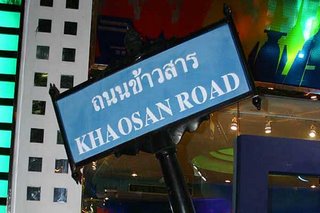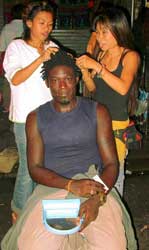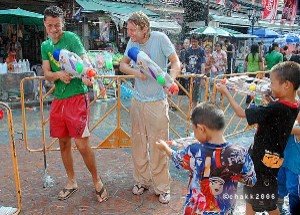 Suvarnabhumi Airport
Suvarnabhumi AirportThe official opening of Suvarnabhumi Airport, Bangkok’s new international airport, on 28 September 2006, gives new impetus to the country’s quest to make Bangkok and Thailand the aviation hub of the region.
Named 'Suvarnabhumi' (meaning 'Golden Land') by His Majesty King Bhumibol Adulyadej of Thailand (Rama IX), the development of Suvarnabhumi Airport as the aviation hub of the region is of strategic importance to Thailand’s future and is a priority on the ‘national agenda’.
During the initial phase of operation, the north section of the airport will accommodate 45 million passengers per year, 76 flights per hour and 3 million tons of cargo handling per year. After the final phase, this will rise to 100 million passengers a year.
At 563,000 square metres, the passenger terminal is currently the largest in the world. The airport also features the world's longest runway, 75.3 metres by 4,000 metres long and the world’s tallest control tower, 132.2 metres high, providing the best visual coverage of overall airside.
When in full operation, the airport will help boost Thailand’s economic, social, communication, and tourism development, and advance the government policy of making Thailand an aviation hub in Southeast Asia.
Suvarnabhumi Airport is located at Km. 15 (15th kilometre milestone) on the east-bound Bangna-Trat Highway in Bang Phli district, Samut Prakan province, east of Bangkok. The airport is approximately 25 kms from the Bangkok metropolis.
As of 28 September 2006, Suvarnabhumi Airport replaces Don Muang airport as Bangkok's primary airport for all commercial airline flights.
Suvarnabhumi Airport is operated by The Airports of Thailand Public Company Limited (AOT). In addition to the new Bangkok international airport, AOT operates four other international airports in Thailand – Chiang Mai, Hat Yai, Phuket and Chiang Rai.
 1. Model Scheme
1. Model SchemeAt the initial phase of service provision, the north section of the airport will be able to accommodate 45 million passengers per year, 76 flights per hour and 3 million tons of cargo handling per year.
1.1 The external of the passenger terminal complex
- The entrance from the Motorway at the north side of the airport is 2-way 8 lane traffic on elevated frontage road, and will increase to 10 lane traffic approaching the airport leading up to the main entrance of the passenger terminal complex.
- The passenger terminal complex has the length of 444 meters and the width of 111 meters. Facilities for both domestic and international passengers are situated in the same building.
- The concourse buildings are connected to the passenger terminal. There are 7 concourse buildings: A, B, C, D, E, F and G. The combined area of the concourse buildings and the passenger terminal expands over 563,000 square meters, whereas the area of the current Bangkok International Airport (Terminals 1&2) totals 321,166 square meters.
- The car parking buildings are situated at the front of the passenger terminal complex. There are 2 car parking buildings with the capacity of approximately 5,000 cars. In addition, there are parking areas on the ground level on the exterior which can accommodate approximately 1,100 cars. There is also a long term parking area that can accommodate approximately 4,000 cars and 78 buses.
- The control tower rises over the height of 132.2 meters. It is the world’s tallest control tower, fully equipped with the best technologies that will facilitate smooth air traffic control. It has the ability to manage approximately 76 flights per hour.
- The airport information management system building is a 6 storey building with the technologies for the purposes of technical management. There are 4 main technical centers: Airport Operation Center (AOC), Security Control Center (SCC), Crisis Control Center (CCC) and Network Management Center (NMC).
The floor plan:
1st floor is for the installation of the foundation structures such as the power distribution system, the security system, fire extinguishing system and the computer and the electronic network systems.
2nd floor consists of the Crisis Control Center (CCC) and seminar rooms.
3rd floor consists of the Airport Operation Center (AOC) and the Security Control Center (SCC)
4th floor is used as administrative offices
5th floor is for the Network Management Center (NMC) and the Benchmark Test Laboratory
- The airport operation building is a 6 storey building which consists of AOT administrative office, offices of airlines and governmental offices, with a canteen on 1st floor.
- The runways that will be open for operation in the initial phase are the Eastern runway with the length of 4,000 meters and width of 60 meters, and the Western runway with the length of 3,700 meters and width of 60 meters.
- Taxiways 52 taxiways are to be in operation service.- Aircraft parking space expands over the area of 1,053,000 square meters for 120 aircraft parking stands, 8 of which are for Airbus A380 (5 of them are contact gates)
2. The airport hotel will be built under the “Novotel Suvarnabhumi Airport” appointed by the AOT on October 24, 2003. This is a joint venture project between 3 parties: the AOT, Thai International Airways PCL and Krung Thai Bank PCL. The airport hotel will cover the ground of approximately 17 rai, located in front of the passenger terminal complex with 300 meters in between. There will be 600 rooms in the hotel, 500 of which will be opened at the initial phase. The hotel will be of recognized international standard with complete lines of services, along with a connecting route linking the hotel itself to the car parking building.
3. Suvarnabhumi passenger terminal complex comprises of 7 stories above ground and 2 stories below ground.
1st floor is the busy lobby. Buses are not allowed to go to 2nd and 3rd floors in order to avoid the traffic congestion. Additionally, there will be a medical center, AOT offices for electricity monitoring and airport control offices.
2nd floor is the arrivals hall for both domestic and international passengers.
3rd floor consists of airlines passenger waiting lounges, some shops, security checkpoints, meeting points, shops, service counters and CIP lounges.
4th floor is the departure hall. This hall features the facilities for both international and domestic passengers, lounges for premium passengers Thai Airways International PLC, customs control checkpoints, some governmental offices, airline booths, airport information counters and escalators in the centre which can take passengers right up to the restaurants on 6th floor.
5th floor is the offices for Thai Airways International PLC and Star Alliance airlines.
6th floor consists of restaurants, which can be accessed via the escalators from 4th floor.
7th floor serves as observation area.
The lower ground floors are termed floor 0 which serves as the train station, and floor -1 which is the place for train platforms. The lower ground floors also function as a place for baggage conveyor systems.
4. The concourse buildings: A,B,C,D,E,F and G have the roofs that are made of glass and special synthetic material which is very tough and durable, with Teflon coated, that will prevent the accumulation of dirt and grime. Passengers can walk to the concourse buildings from the terminal complex via the concourse building D, which is directly connected to the terminal complex.
The concourse buildings A and B are for domestic passengers. Details are as follows:
- Concourse building A is for domestic passengers, with the length of approximately 432 meters. This building can accommodate 6 aircrafts and has 1 connection channel that allows access to the remote parking bays.
- Concourse building B is for domestic passengers, with the length of approximately 270 meters. This building can accommodate 6 aircrafts and has 2 connection channels that allow access to the remote parking bays.
The Concourse buildings C,D,E,F and G are for international passengers. Details are as follows:
- Concourse building C has the length of approximately 459 meters, and can accommodate 10 aircrafts with 2 connection channels to access to the remote parking bays.
- Concourse building D has the length of approximately 909 meters, and can accommodate 8 aircrafts with 2 connection channels to access to the remote parking bays.
- Concourse building F has the length of approximately 270 meters, and can accommodate 6 aircrafts with 2 connection channels to access to the remote parking bays.
- Concourse building G has the length of approximately 432 meters, and can accommodate 5 aircrafts with 1 connection channel to access to the remote parking bays. VIP lounge also situated at this building.
The intersections of the concourse buildings are termed the airside center. There are 2 intersections on 3rd and 4th floors which will be used for shops; the exterior of the concourse buildings will be developed into airline offices and airline lounges.
 5. Passenger Flow
5. Passenger Flow5.1 International passengers flow
5.1.1 Departure passengers can come through via the entrance on the 4th floor of the departures hall, which can be accessed by car or by foot from the car parking buildings, which is connected to the 3rd floor of the departures hall. Upon entering the departures hall, passengers can check-in at counters 4-10 before proceeding to the passport control and the customs control checkpoints. Passengers can then continue to the concourse building D via 2 connection channels from the terminal complex. The 4th floor of concourse building D consists of a wide variety of shops that passengers can enjoy shopping while waiting for board. When called for boarding, they can approach the gate via the 3rd floor of the departures hall; and when arrive at the gate, they have to proceed to the 2nd floor to the hold room.
All passengers and hand luggage taken on board must be examined. The examination points are on 3rd and 4th floors in the airside area of the concourse buildings.
5.1.2 Arrival passengers can come through to the passenger terminal on 2nd floor of the concourse buildings except the bus gate passengers. At the terminal, there will be passport control checkpoints and this is also a place where they collect their baggage from on of the 22 baggage conveyor belts, 17 of which are for international passengers and 5 are for domestic passengers. Once passengers have collected their baggage and passed the customs control checkpoints, they can proceed to the arrivals hall where they can find transportation counters, hotel and accommodation counters and tourist information center. Outside the arrivals hall will be pick-up points; in the case of passengers traveling with tour agency, they must proceed to 4th floor for buses and coaches. There is a general meeting point on 3rd floor.
5.1.3 Transit/transfer passengers will have to go to the airside area after they arrive at the 2nd floor of the concourse building from the aircraft in order to proceed with the transfer processes before continuing to 3rd and 4th floors to complete the departure procedures.
In the case of transit passengers, they will have to go through the airside area to the departures service area in order to complete the departure procedures.
5.2 Domestic passengers flow
5.2.1 Domestic departure passengers will be able to check-in at counters 2 and 3 on 4th floor of the departure hall. Afterwards they will have to proceed to 2nd floor to the hold room where they and their hand luggage will be examined.
5.2.2 Arriving passengers will come to the terminal through the 2nd floor of the concourse building to collect their baggage from the 5 domestic baggage conveyor belts before proceeding to the arrival hall. The service counters outside the arrival hall will be shared by both the domestic and the international passengers.
6. Road Network6.1 Road networks within landside
There are 5 access routes to passenger terminal complex from the road networks within the landside.
6.1.1 Access route from the North
Passenger terminal complex can be accessed from the North entrance via the motorway. The elevated frontage of the terminal is divided into inner and outer parts for both the arrival and the departure halls.
6.1.2 Access route from the Northwest
Passenger terminal complex can be accessed from the Northwest entrance via the Rom Klao elevated highway and King Kaew Road which will pass the customs free zone before arriving at the terminal.
6.1.3 Access route from the South
Passenger terminal complex can be accessed from the South entrance via the Bang Na-Trat highway and the service road which will pass the long term parking area and the public transportation center before arriving at the terminal.
6.1.4 Access route from the Northeast
Passenger terminal complex can be accessed from the Northeast entrance via the Lad Kra Bung (Onnuj Road), then through the East-West main service road within the airport, the long term parking area and the public transportation center before arriving at the terminal.
6.1.5 Access route from the West
Passenger terminal complex can be accessed from the West entrance via King Kaew Road.
6.2 Road networks within airside, the area which features runways, taxiways, aircraft parking space, ground equipments and services for aircrafts and baggage management area. There are 4 access routes from landside to airside.
1st access route is adjacent to the concourse building G.
2nd access route is adjacent to the concourse building A.
3rd access route is in the domestic cargo warehouse area of Thai Airways International PLC
4th access route is adjacent to the ground customer service building of Thai Airways International PLC
7. The Transportation System Service7.1 Buses and coaches for passengers traveling with tour agencies are able to drop off the passengers at 4th floor of the passenger terminal complex for departure passengers. Buses and coaches will have to park at the public transportation center. As for the arrival passengers, there are pick-up points at 1st floor of the terminal.
7.2 Airport shuttle busses will be in service for the personnel and passengers traveling between the public transportation center, the long term parking area and the passenger terminal complex. At the initial phase, there will be 3 routes.
Route 1 is for people who want to minimize the traveling time. The distance will be 8.7 kilometers. The starting point is at the public transportation center and there is only one pick-up point at the long term parking area. One round trip takes approximately 10 minutes.
Route 2 is for passengers who park their cars at the long term parking area. There are approximately 11 pick-up points along the journey. The trip from the parking area to the terminal takes approximately 11 minutes, and the return trip 16 minutes.
Route 3 is for passengers traveling between the terminal and the public transportation center. There are approximately 10 pick-up places along the journey.
The trip from the public transportation center takes approximately 11 minutes, and the return trip 16 minutes.
7.3 Private cars can be parked at the parking building after dropping off passengers at the 4th floor of the terminal complex. Pick-up points are on the 2nd floor.
7.4 Taxis can drop off passengers at the 4th floor of terminal complex, and will have to leave the area immediately. Pool taxis can wait for passengers at the public transportation center.
7.5 Limousines can be ordered at the service counters outside the terminal on the 2nd and 4th floors but will be parked at the public transportation center.
7.6 Airport express service will be operating between the airport, hotels and various important places in Bangkok and the suburbs.
7.7 Public bus services (air conditioned) will be operating in 6 routes
1) No. 549 Suvarnabhumi – Min Buri – Bangkapi
2) No. 550 Suvarnabhumi – Happy Land
3) No. 551 Suvarnabhumi – Victory Monument
4) No. 552 Suvarnabhumi – Onnuj BTS Station
5) No. 553 Suvarnabhumi – Samutprakarn
6) No. 554 Suvarnabhumi – Rangsit (Special Route for Suvarnabhumi – Don Meung - Bangkok International Airport)
All the bus services operating along all these 6 routes will drop off airport passengers at the public transportation center.
7.8 Trains by the State Railway of Thailand will be in service between Suvarnabhumi Airport and major places in Bangkok and the Suburbs. There will be an electric train service between Suvarnabhumi Airport rail link and the city air terminals along the East rail track totaling 28 kilometers. There are 8 city air terminals : Phyathai, Ratchaprarop, Makkasan/Asoke, Ramkamhaeng, Huamak, Bantubchang
Ladkrabung and Suvarnabhumi.
More details about Suvarnabhumi Airport, please click.
Source: The Airports of Thailand Public Company Limited (AOT)Tanks “Tourism Authority of Thailand” for all Details.
Tanks “SHUTTER PHOTOGRAPHY Magazine Thailand” for all Pictures.
Thai FoodsThai HerbThai Hotel




















 S
S

